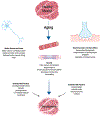Maintaining Muscle Function Across the Lifespan: The State of Science
- PMID: 32282363
- PMCID: PMC7544643
- DOI: 10.1097/PHM.0000000000001429
Maintaining Muscle Function Across the Lifespan: The State of Science
Abstract
Sarcopenia is a geriatric syndrome currently defined as pathological loss of muscle mass and function. Sarcopenia is not only a major contributor to loss of physical function in older adults but is also associated with increased risk of morbidity, mortality, and increased healthcare costs. As a complex and multifactorial syndrome, sarcopenia has been associated with numerous degenerative changes during the aging process, but there is building evidence for significant contributions to the development of sarcopenia from neurodegenerative changes in the peripheral nervous system. A variety of interventions have been investigated for the treatment of sarcopenia, but current management is primarily focused on nutrition and therapeutic exercise interventions. Great strides have been made to improve screening procedures and diagnostic criteria for sarcopenia, but continued optimization of diagnostic and screening strategies is needed to better identify individuals with sarcopenia or at risk of developing sarcopenia. Understanding and addressing the major drivers of sarcopenia pathogenesis will help develop therapeutics that can reduce the impact of sarcopenia on affected individuals and society.
Figures
Comment in
-
Physiatric Evaluation and Management to Optimize the Care of Older Adults at Risk for Sarcopenia.Am J Phys Med Rehabil. 2021 Sep 1;100(9):e136-e137. doi: 10.1097/PHM.0000000000001766. Am J Phys Med Rehabil. 2021. PMID: 33852493 No abstract available.
References
Publication types
MeSH terms
Grants and funding
LinkOut - more resources
Full Text Sources
Medical
Research Materials


